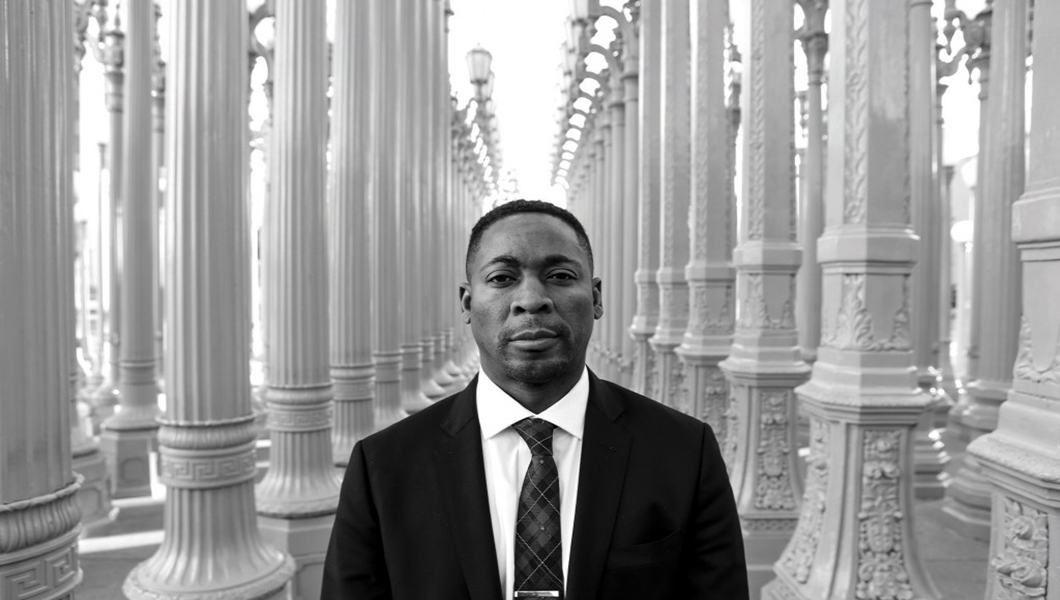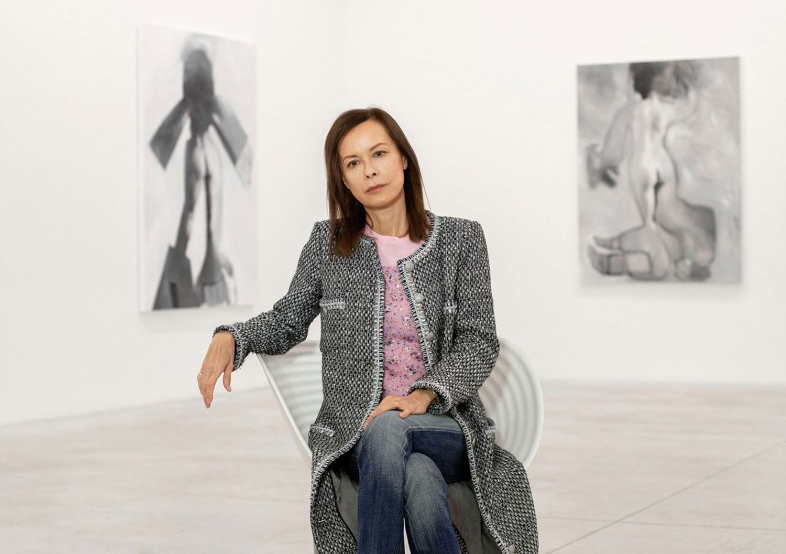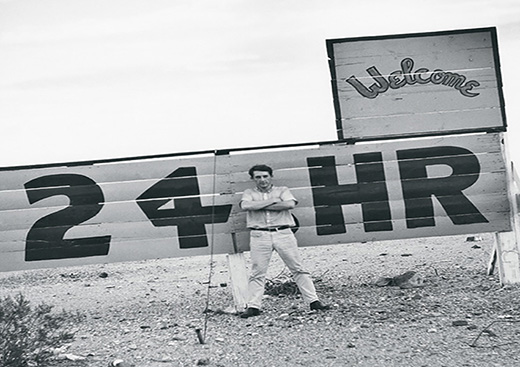“It’s all about looking and knowing,” says Franklin Sirmans, who has been head curator of the Los Angeles County Museum of Art’s contemporary art department since 2010. We are walking through Lost Line , an exhibition mostly organized by Sirmans’ colleague, Rita Gonzalez, on the second floor of the museum’s Broad Contemporary Art building—or BCAM, as everybody calls it. But even if Gonzalez spearheaded this show, it does what the contemporary department has been doing for the last four years: exploring connections between art from now and then in the museum’s collection, trying to figure what the museum has, and should have, and what the work can say together.
This may sound like a run-of-the-mill undertaking, but it’s actually not. Often, when you visit a “from the collection” show at a major museum, you feel that history is set, its major players chosen, and that you are simply being shown some of its highlights. Lately at LACMA, shows from the collection have been flexible propositions about how history might work. This openness feels almost radical.
We have just looked at a panorama by Argentina-born, Londonbased Amalia Pica, a younger artist new to LACMA’s collection. It spans the length of half a wall, and it’s made up of grainy, letter-size photocopies that come together to show a woman standing on a rock with a megaphone at her side. She stares out at a landscape much bigger than she is. On the adjacent wall hangs a framed letter and image detailing a work Terry O’Shea made in 1972. Sirmans tells me the story, versions of which I have heard before: O’Shea, who had won the museum’s Young Talent Award, had produced a geometric resin sculpture, then drowned it in the La Brea Tar Pits, those bubbling pools of tar adjacent to LACMA’s campus. Pica wasn’t even born when O’Shea threw his sculpture into the pits, but her work, like his, suggests the impossibility of competing with the grand bigness of the natural world. Making loose, cross-generational connections like this is something Lost Line does nicely.
“We’re dealing with 1968 to the present, and having a building with 1968 to the present, and having a building that’s theoretically just dedicated to contemporary [art], it’s very exciting,” says Sirmans, referring to BCAM, which opened in 2008, thanks to financial Backing from philanthropist Eli Broad. “How do we deal with this? How do we acknowledge how contemporary art changes?”
Sirmans, who grew up in a 1980s New York where he likely saw Keith Haring drawings on subway walls out of the corner of his eyes, became fascinated in high school by Jean-Michel Basquiat’s merging of street, expressionism and tribal history. He studied English literature and art history at Wesleyan, where he wrote his thesis on Basquiat. Then he took a job in finance. But because of his thesis, Thelma Golden, then curating a Basquiat show at the Whitney Museum, asked him to write a chronology of Basquiat’s life and work for the catalogue. So began a career that took him to Milan, where he was U.S. news editor for Flash Art, to DIA Beacon outside of New York, where he worked in the publication Office. In the 2000’s, he curated or co-curated shows like OnePlanet under One Groove at the Bronx Museum or Make It Now: New Sculpture in New York at the Sculpture Center. Then, in 2006, he went to the Menil Collection, a private Houston museum, to serve as curator of modern and contemporary art.
Sirmans began thinking about Los Angeles before he knew he would move here. Still at the Menil, he had been asked to write an essay for the Now Dig This: Art and Black Los Angeles 1960 – 1980 catalogue. Now Dig Thi s would open at the Hammer Museum in 2011, feature primarily assemblage art—works made by piecing together found objects and disparate materials—and trace the post-1960 influence of L.A.’s black artists. Instead of writing about those artists or assemblage specifically, Sirmans chose his subject the curator Walter Hopps. Perhaps because Hopps had been the Menil’s first director, his approach to exhibition- arranging was on Sirmans’ mind.
Hopps, the son of L.A. surgeons marked by his thick hair and thick-rimmed glasses, studied microbiology in school but had already begun his love affair with art history—school trips to museums had led to visits to local collectors’ homes. He married an art historian he met at UCLA, Shirley Nielson, at the base of the Watts Towers in 1955 and opened Ferus Gallery in 1957. The space would offer Andy Warhol his first show and champion the smooth, cool light and space art that would become a SoCal trademark. It also introduced some West Coast found-object art, though Hopps would promote that art to greater effect later, organizing, among others, an exhibition of black assemblage artist Noah Purifoy’s work at the Washington Gallery of Modern Art in 1968.
“Though I came to the guiding light late,” Sirmans wrote in the now-published catalogue, “I imagine that when curators of my generation were young and dreamed of being curators, visions of Walter Hopps danced in their heads.”
Hopps was a “curator’s curator,” says Sirmans. “He had this commitment to really clearly asking, ‘What does it look like?”” Hopps organized the first retrospective of Marcel Duchamp, the artist perhaps best known for the urinal he turned 90 degrees, named “Fountain” and exhibited at the Society of Independent Artist in 1917. The influence of his pragmatic radicalism on artists in the U.S. was undeniable, but no U.S. curator had paid him such close attention before. “[Hopps] would say, ‘This person is worthy of this sort of treatment,’ and because you give them this sort of treatment, you’ll learn from it,” says Sirmans.
If you read the press announcing Sirmans arrival and departure from the Menil and announcing his arrival at LACMA, words like these appear: “quirky,” “mash-up,” “diversity,” “reinvigorated,” “fresh,” “range of interests.” Collectors and members of art collector committees who have gone on tours with him will say they “like the way he talks about art,” and what they seem to mean is that he makes art—even iconic, canonized objects like Mondrian abstractions or Rauschenberg combines—seem openended and unpretentious but still genuinely interesting.
When Sirmans arrived at LACMA, the museum was in flux. Michael Govan had been director for just over two years. BCAM had just opened, its third floor filled with flash, expensive work from Eli Broad’s collection. Christine Kim, formerly of the Studio Museum in Harlem, had recently joined the contemporary Department as well. “Michael [Givan] said, ‘Dive in,’” Dirmans remembers. So he, Gonzalez and Kim worked through the collection, assembling a show they would title Human Nature. “We had four rooms to say, ‘This is how things were different [after 1968’],’” says Sirmans/ The first room included Bruce Nauman’s Walk with Contrapposto, a video in which the artist sways his hips in an exaggerated way while walking along a narrow corridor, and a photograph by Hannah Wilke of herself topless with kneaded erasers stuck to her face and chest, wielding two toy guns. Starting with work like this, that deals with rawness and embarrassment, rather than flashier pop- or minimalism- informed work from around that time, felt like an announcement that LACMA was going to do things differently.
Right now, Sirmans, who is working on the Ends and Exits show on art from the 1980s scheduled to open this spring, has images of work by savvy appropriation artist Sherrie Levine and the sometimes abject, sometime elegant Robert Gober on his office wall. Works by both of them will go into the show. And he’s been looking at Basquiat again, as he crafts yet another essay on the artist. Recently, he spent time in front of “Gold Griot,” now owned by The Broad Art Foundation in Santa Monica. The work features paint stick on horizontal panels of wood, depicting a wildly grinning man with a skeletal torso, wide eyes shaped like sunflower seeds and teeth that look like blue, red and white
“Seeing it again now, I see how much the head is a split between an African mask and something like a carnivalesque costume,” says Sirmans. “You know it better every time you stand in front of a painting. Each time of writing is a time of trying to reckon with it, saying to it, ‘Tell me something else.’”
—





